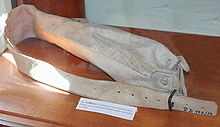Money cat
The term money cat (also known as cat for short ) can refer to several different forms of purse: A bag in different shapes attached to the belt , mostly for storing coins, but also small valuable objects such as rings, stones or pieces of precious metal , or a belt with an integrated money compartment . The term is independent and was widespread in the Middle Ages.
Origin of the term
There are several explanations for the origin of the name. It is possible to name it after production, because the belt pouches were often made from the skin of a cat (cat leather). The term can also stem from the fact that the shape of the pouch worn on the belt is reminiscent of a small cat's head.
More likely, however, is a derivation from the Old High German chazza for "vessel, bag to carry" or from the Arabic خزىنة ḫazînâ cash box, safe, state treasury .
The cat was worn in the Middle Ages and again in the early and mid-19th centuries, often decorated with pearl beads or embroidery .
nature
The money cat of the 19th century is a tube-like sewn bag made of leather, closed at both ends, but mostly knitted or crocheted. There is an elongated slot on the long side. If this tube is hung over the belt, two small bags are created in which the money is kept. The pouch can be worn inside or outside of clothing. Because the slot is on the long side that lies above the belt, the coins cannot be accidentally lost. Often two metal rings were also attached as a closure. The cat is removed from the belt to pay.
Historical end and today's meaning
With the advent of paper money , the everyday use of the money cat was lost. The exchange value of coins became increasingly lower, so that wallets and purses could prevail in everyday use.
The money cat has kept the phrase "Rubbel die Katz '" to this day - as an invitation to act quickly. Anyone who “scratched” the cat during price negotiations counted the coins in the bags by swiping over them without removing them - so they were about to make a purchase decision.
See also
Individual evidence
- ↑ The window in the Kreissparkasse Cologne , No. 111: From the money cat to the wallet (PDF; 4.4 MB), 1981.
- ↑ Friedrich Schmitthenner: Short German Dictionary for Etymology, Synonymics and Orthography , Darmstadt 1834.
- ↑ Heinrich Tischner: Etymologie Sprachen Arabic ( Memento of the original from May 28, 2010 in the Internet Archive ) Info: The archive link was inserted automatically and has not yet been checked. Please check the original and archive link according to the instructions and then remove this notice. .

